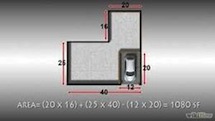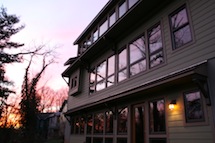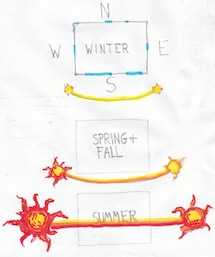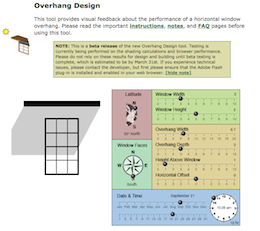Passive Solar Design

Passive Solar Design PSD is traditionally described as using a home's windows to get free heat from the sun. Passive solar includes details that reduce or block unwanted sunlight in the summer. Of the 3 forms of solar energy only passive solar design is capable of zero added upfront costs. Even homes not trying for PSD can save energy and increase resilience by paying attention to these details. This is the most cost-effective way to heat a home or building.
For potential investment of nothing, one gets free heat in the winter, free daylighting all year, and an important element of passive survivability, which better resists power outages and disasters. Passive solar design performs best with high efficiency building envelopes, proven airtight, with outdoor-air ventilation.
 What is a Building Envelope?
What is a Building Envelope?  The Blower Door Test.
The Blower Door Test.  Outdoor-Air Ventilation
Outdoor-Air Ventilation
Passive solar is broad in scope and this post offers a simple approach with measurable, cost-effective results. After blower door diagnostics, these are the variables most associated with cost-effective building performance in our climate. In most climates, it starts with sun-facing window to floor area.
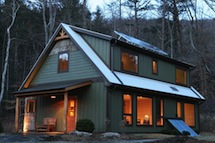 South-Facing Window to Floor Area
South-Facing Window to Floor Area
This is the most descriptive variable for passive solar design. The total window area on the south side of a home, divided by the home's total floor area, results in a percentage of passive solar heating potential.
Rough openings or window sizes are often used for calculating window area but the window parts block sunlight and need to be accounted for. Frames, dividers, and sash parts reduce window areas by 10-40%. Bigger, fixed windows and smaller frames have less reductions.
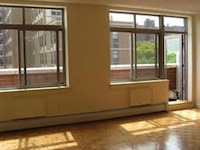 Floor area is generally considered the home's total conditioned square footage. Example: 200 square feet of south window area for a 2000 sqft home.
Floor area is generally considered the home's total conditioned square footage. Example: 200 square feet of south window area for a 2000 sqft home.
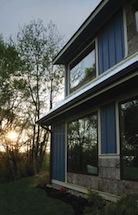
200-40(.2 reduction) / 2000 = 8% south window to floor area.
| 5 - 7% | Sun-tempered, Fair target for high performance building envelopes. |
| 8-12% | Traditional passive solar design. Some spring but mainly fall overheating. |
| 13% + | This much south glass risks considerable overheating concerns. |
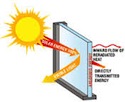 South-Facing Windows Needs High SHGC glass.
South-Facing Windows Needs High SHGC glass.
Solar Heat Gain Coefficient SHGC is an important performance measurement for windows. Normally in our climate, lower SHGC windows are better, because orientations are generally ignored. Low SHGC is crucial for east and west-facing windows. For properly shaded south-facing windows, high SHGC is better. North-facing windows benefit from high SHGC, but codes only allow so much.
Glass SHGC vs Window unit SHGC
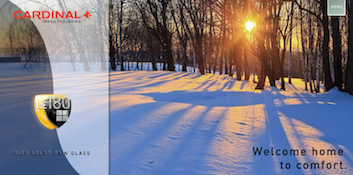
Most window labeling refers to the window units which include shade producing window parts. Glass-only values for high SHGC windows range from .5 -.7 . This results in a good passive solar window unit with a total SHGC in the .4-.6 range.
Passive solar design requires performance modeling based code compliance as most code authorities are enforcing maximum SHGCs in the .3-.4 range. With such low SHGC values, passive solar heating potential is substantially reduced. Bumping up the the SHGC of south-facing windows is easy money.
Orientation
The ideal orientation for northern hemisphere PSD's sun-facing, heat producing windows is south or southeast. Southwest orientations experience more overheating concerns but smart shading helps. Most sites don't allow perfect alignment but that's ok. Being within 20 degrees of south is best but even 40 degrees can be advantageous depending on design, shading and site specific details. Warm climates benefit the most from avoiding western orientations.

Choosing windows part 2 has more on the influence of directional orientation.
For climates with cooling needs, reducing east and west wall areas has dramatic effects on energy use and comfort. Summertime paths of the sun inflicts direct angles on walls which have less thermal resistance than roofs. Windows make things worse and its important to specify Low SHGC glass for the east and west. Choosing light colored siding helps, but the roof represents the most value by selecting roof finishes with good reflective performance.
 Shape
Shape
Most passive solar designs orient a long side to the south. Skinny sides can face south but distribution is less even and extra engineering may be involved to get enough window area out of the smaller wall area.
Jogs or bumpouts on the south sides of a home have shading effects on windows immediately to their sides. This can be a good thing for southwest orientations but its usually not desirable. Covered porches and decks need to be eliminated on the south, for any level below them, to have heating potential. 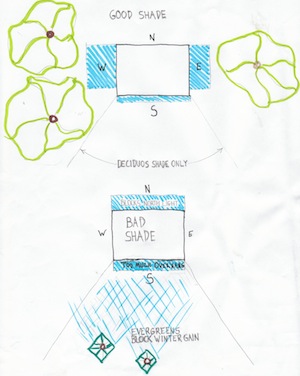
Good Shade Bad Shade
Homes and buildings need to hold their own without landscaping. Designers relying too much on landscaping are thwarted by the lengths of time it can take to develop mature plantings. Covered porches and decks provide shade and are best placed on the east and west. Notice how relatively small the south overhang is to allow full sunlight in the winter.
Landscaping helps reduce energy use tremendously and the east and west are where to focus efforts. Large trees block direct sunlight from hitting walls and can even be used to shade the roof. There is a tricky balance between tree growth for shading and the increased danger of falling limbs.
Evergreens need to be avoided on the south but even heavy deciduous shading still works fine. Covered porches or deep overhangs on the north block interior light. Northern climates can have deeper southern overhangs but be careful making the overhangs too deep or too close to the top of the window.
South Overhangs: Depth and Height Above The Window
For a better understanding of south-facing overhang design, a good resource is Sustainable By Design's Overhang Tool. Enter the latitude, orientation, window and overhang sizes, and it animates the shading effects for windows.
How deep the overhang is and how high it is above the window are manipulated to provide shade on the summer solstice and sunlight on the winter solstice, allowing sunlight when you want it and shade when you don't.
One of the best resources for window design is RESFEN, computer software that models energy use. By using RESFEN designers can optimize window design, performance and cost-effectiveness.
Overheating
Even properly designed passive solar designs face overheating concerns in the spring and especially the fall. On warm days during these shoulder seasons, the sun has a lower path in the sky and will contribute heating when it is unwanted. Thermal mass can help, but shading and south window area have more measurable results at preventing it.
Cooling dominated climates need to be careful with their use of high SHGC glass, even on the south sides of a home. Designers in warmer climates or those with southwest orientations might want to include deeper overhangs to better protect from overheating during the shoulder seasons. Tight fitting blinds or exterior shutters are far more effective than additional thermal mass.
Other passive solar stuff
This is where cost-effectiveness drops off the map. While these variables affect performance, their benefits get hard to measure and can add risks.
Thermal Mass
A relevant topic getting too much attention. Thermal mass is heavy, which tends to make it expensive and environmentally wasteful. Its particularly useful when needed anyway in construction but it rarely makes sense to spend money adding more. Homes on slabs have plenty of thermal mass and sunlit floor areas are a good storage option. Light colored floors in sunlit areas with darker thermal mass in the back, is another idea. More pros and cons of thermal mass at GBA article all about thermal mass and here:
 Radiant Floor Heating
Radiant Floor Heating  Natural Building
Natural Building
Active distribution
Anytime one uses a fan or circulator, the term passive gets looser in meaning. Active distribution for passive solar needs to be careful with its use of grid energy. Good passive solar design need not rely on moving parts.
There are other passive solar design strategies like trombe walls, solar chimneys, attached greenhouses and rock storage beds but they present more problems than they solve. Passive solar design is the most cost-effective way to heat one's home and the details above offer the simplest path.
Springtime Builders is an Asheville NC custom home builder specializing in passive solar design. Our Springtime Cottage is a passive solar design plan we sell and consult on. We also consult and collaborate with designers and homeowners seeking to improve the passive solar performance of thier projects.
This article in Green Building Advisor is a resource for designers, builders and homeowners looking to implement passive 
Cost-Effective Passive Solar Design

This Fine Homebuilding article covers our Springtime Cottage, a passive solar design plan.

Summertime Passive Solar Design
Posted in Heating and Cooling
